A great training gauge, thoroughly explained in depth by the late Christian Thiess – photos from THM files
Have you ever been schooling a horse on your own and wondered if there is a way to accurately test to see if your horse is working correctly? Have you ever been instructing and looked for a method to gauge if the pupil’s horse was really on the aids and engaged from behind in self-carriage? Or have you been judging a dressage test and wondered if behind that immaculate turnout and smiling rider, the horse was truly established at the standard required? There are a series of irrefutable tests that can honestly answer your questions.
Riders, trainers and judges can use the test appropriate to the horse’s stage of development to check on anything from engagement and self-carriage through to straightness and relaxation. You don’t have to rely on ‘feel’ or good luck to guess if your horse is established at a particular level. You can put it to the test!
The tests, or ‘truth-stones’, include the full halt, medium trot and piaffe, plus one test that has the advantage over all the others in that it can accompany the horse throughout his entire development… Showing the horse the way towards the ground. In this article West German trainer, Christian Thiess takes a closer look at this crucial test, and the contribution the exercise can make to your horse’s training programme…
There seems to be two conflicting streams of thought amongst dressage enthusiasts on the subject of showing the horse the way towards the ground. One group firmly believes it is an exercise without benefit that contributes nothing towards developing the horse’s natural ability. Indeed they suggest it may even be damaging because it encourages the horse to lengthen his frame rather than rounding his body and striving towards collection.
Then there are people who hold the opposing view, firmly believing that it is an invaluable exercise with countless benefits.
Who is right?
Are the ‘go long’ believers just a band of diehards refusing to bow down to the progressives amongst us? Or does the exercise with the long winded name really have some benefits to offer?
I firmly believe a lot of criticism has arisen against showing the horse the way towards the ground because of a lack of understanding. A lot of riders simply do not know how to correctly perform the exercise.
They may make some sort of vague attempt to do so, but, like any incorrect riding, they can actually cause damage by encouraging their horses to fall on their forehands, lose rhythm and flatten their backs.
How many times do you see it? Uneducated riders endlessly trotting round on a long rein with their horse’s nose strung out somewhere in front and the poor animal so on the forehand that he is nearly falling over himself… and this is supposed to be a beneficial exercise!! It is hardly surprising that riders and trainers dispute the value of showing the horse the way to the ground…
But, correctly performed, when the rider has gained a true understanding of the theoretical and practical aspects of the exercise, showing the horse the way to the ground has a real place in the horse’s preparation.
I am sure the problem lies with riders not understanding what the exercise is all about and how to ride it.
The English language is renowned for its clumsiness in explaining many equestrian terms, and its awkwardness in adequately expressing a name for this exercise is just one example. The Germans have two expressions for it Zugel aus der Hand kauen lassen – which translates as “allow (the horse) to chew the reins out of the (rider’s) hand” and dem Pferde den Weg in die Tiefe zeigen – which is to “show the horse the way in the deep”, which doesn’t quite meet English grammatical standards, so it is usually altered to “showing the horse the way to the ground” in line with the translation originally used in Wilhelm Museler’s book, Riding Logic. I have elected to use the second expression with one slight alteration- simply because I think it most clearly explains the aim of the exercise … despite the large number of words involved!
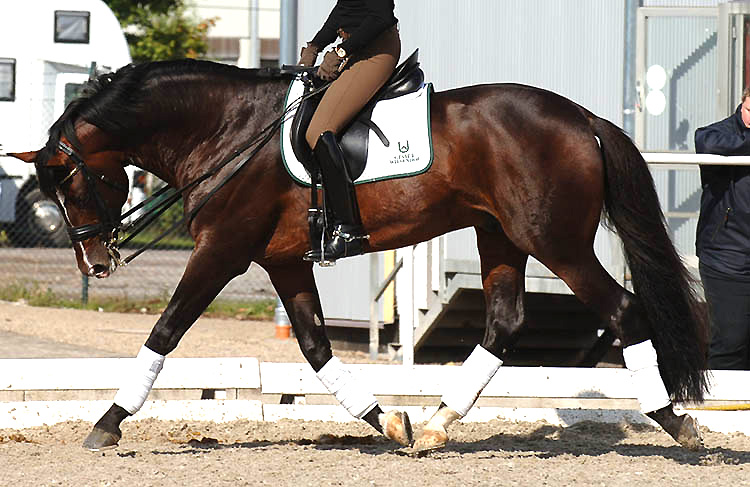
It is important that before the rider makes any attempt to perform the exercise, he makes sure that the horse is moving forward with impulsion at the selected pace, in good rhythm and contact with the bit. Then, while maintaining the forward driving aids, the rider should begin by giving slightly with the outside rein by moving the hand forward. As the horse responds by stretching his neck downwards and seeking the bit, the rider should offer the inside rein and again the horse should search to maintain the contact. The rider can then begin to lengthen the reins slightly by allowing them to slip through the fingers. Providing the horse is still being driven correctly from behind he will maintain the contact as he chews the bit towards the ground.
I cannot over emphasize that the rider must keep a soft contact with the horse‘s mouth throughout the exercise and never just throw the reins away!
As the muscles become free of tension and elongate, the horse is able to move with a soft swinging back and rounded outline.
If the horse is established, he will maintain the rhythm, engagement and roundness of the pace only altering his outline; although the exercise itself will effect the horse’s entire body. It is a little like a chain reaction because, as the horse lowers his neck, he stretches and relaxes those muscles and as the neck muscles are connected to the back muscles, he also stretches and relaxes this set, and through them, the muscles in his hindquarters. As the muscles become free of tension and elongate, the horse is able to move with a soft, swinging back and rounded outline.
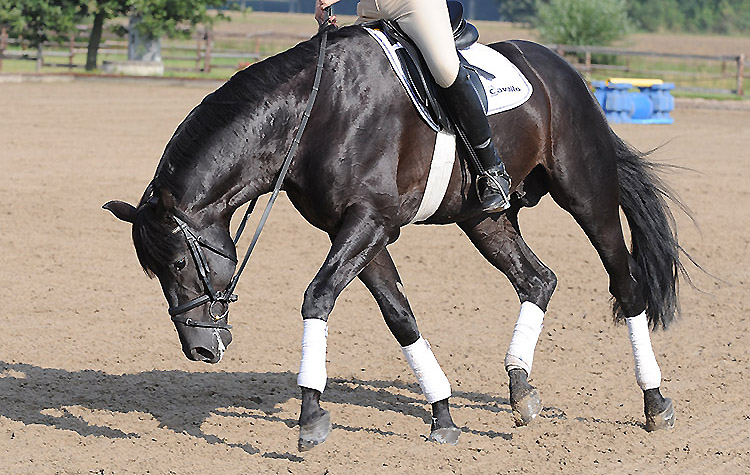
We have established the essential requirements for correct gymnastic work. Many riders seem confused over the angle the front of their horse’s face should take when he lowers his neck. Some seem to think the horse’s nose should be poked way out in front, although when the horse is working with his neck at a normal level they would never accept this as being correct – and the same rules apply for showing the horse the way towards the ground.
Although the horse is now moving with a lowered neck, he should still maintain a quiet contact with the rider’s hand and remain engaged and moving forward from behind – in other words, the horse should remain on the bit.
To be correct, the angle of the head to the neck should remain the same as when the horse was working with his neck in the more elevated position. This means that when the horse lowers his neck towards the ground his face line will have to become behind the vertical to maintain the angle.
The horse is not overbent in this position as he maintains an even contact with the bit. It is not a forced position as the angle of the poll is not restricted and the flexion between the poll and the first vertebra remains similar to what it was before. Only at this angle can the rider continue to influence the horse and gain the full benefits of the exercise. If the horse’s head and nose are allowed to poke forward, everything is lost – as the horse will fall on his forehand, flatten and stiffen his back muscles and lose the rhythm. However if the exercise is performed correctly, it offers several benefits. The first, and most often mentioned, is that it aids relaxation for both the horse’s body and his mind.
The importance of relaxation cannot be overstressed for only a relaxed horse is able to develop athletically in its entirety, improving the suppleness and coordination of his joints and muscles.
This is not to say this exercise is the only method to relax a horse, but it is a valuable aid. It is also an exercise that helps increase the suppleness of the top line of the horse by freeing it of restraint. Remember that horses were not structurally designed to carry the burden of a rider and, under stress of constantly being asked to perform demanding movements, a horse will tend to flatten and stiffen his back.
When the horse chews the bit towards the ground, we encourage him to relax his back and swing his hindquarters, thereby making it easier for him to step further underneath himself and work in a rounder outline.
The most valuable contribution of this exercise to the training of both horse and rider is that it is one of a series of tests to gauge the progress of both horse and rider.
Only if the rider really has the horse working correctly, accepting the leg and bit and engaged from behind, will the horse be able to lower his neck while maintaining the rhythm and impulsion… and not fall on his forehand and run away.
Showing the horse the way towards the ground is the most valuable of the series of exercises available to test the horse’s progress – because this exercise can accompany a horse from his basic introductory training through to the most advanced levels.
As the horse becomes more advanced, only the expectation of how precisely the horse should perform the exercise and the requirements it will test, will change. For example, at the lower levels, it can be used to assess the degree of relaxation and acceptance of the bit, whereas at an advanced level it measures balance and self carriage and can highlight hidden rhythm faults.
It is also a test to see whether the rider has a calm hand and the horse has the confidence to seek the contact offered by the rider, and if the rider can coordinate and come through with the aids.
Showing the horse the way towards the ground is an extremely valuable test that tells no lies. Used by discerning riders it can highlight weaknesses in the horse’s training programme that must be corrected. If you don’t wish to know the truth about your horse’s training progress, then perhaps this is an exercise you should avoid! But, for those riders wishing to know their real progress, the exercise can be used with advantage at any time during a work out, and especially after a period of demanding work as relaxation and reward, or if the horse becomes tense, and at the end of the session to ensure that the horse returns to the stable in a relaxed and happy mental and physical state.
The exercise can be used at all paces, including sitting trot, but it is most commonly executed at the rising trot especially with younger horses. Analyse your horse’s performance during the exercise so you use any resistances that show up as evidence that there are weaknesses in his training programme.
In particular:
tossing the neck
throwing the head up and down
snatching the reins from the rider’s hands
tensing or hollowing the back
– all show a lack of acceptance of the bit, or confidence in the rider’s hands and a lack of relaxation.
While:
loss of rhythm
falling on the forehand
running away/increasing the speed
jogging at the walk
mincing the steps at the trot
– all show that the rider is failing to come through with his aids to adequately engage the horse from behind, or possibly that the horse lacks confidence in the rider’s aids through confusion or lack of coordination on the rider’s part.
In this way, the rider can judge how the horse’s preparation is progressing. If necessary, he can add extra exercises to help overcome weaknesses and he can continually monitor daily progress by showing the horse the way towards the ground.
If all these benefits are still not enough to convince you of the value of the exercise, there is one extra advantage. A horse that can be shown the way towards the ground correctly will be a master of the extended walk for he will have the confidence and ability to march rhythmically forward into a steady contact with maximum length of stride and energy. Gone will be the days of shuffled running steps and contracted neck or dropped contact… how often do you see a true extended walk at the advanced level?
The roundness can be achieved. The horse is engaged from behind and is driving his hindlegs up underneath his body. His back is relaxed and swinging and the horse is happily chewing the bit downwards. That shows the gymnastic value of the exercise and the contribution it can make towards correct muscle development.
Want to breed to one of the most successful ‘D’ line stallions ever? You can…
De Niro is available in Australia from International Horse Breeders, go to www.ihb.com.au
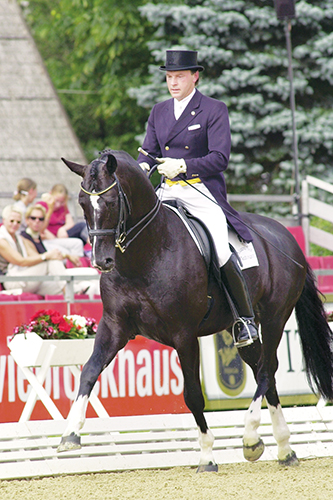
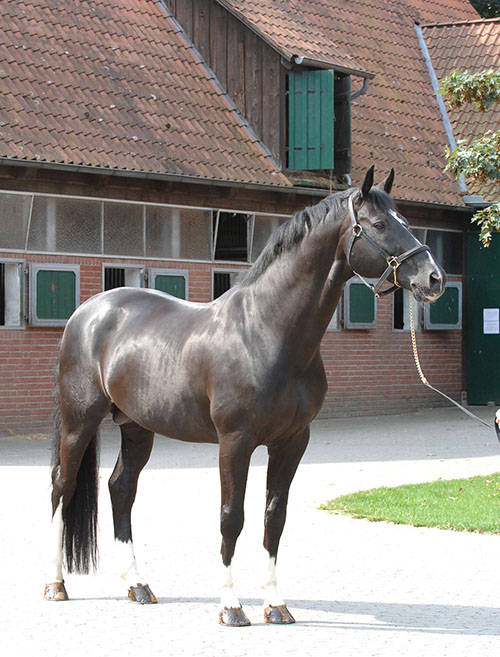
Or his son, Delatio (De Niro/Rubinstein), plus many more stallions from the famous ‘D’ line…
Want to enjoy the world’s largest library of dressage training articles? It’s free, just click

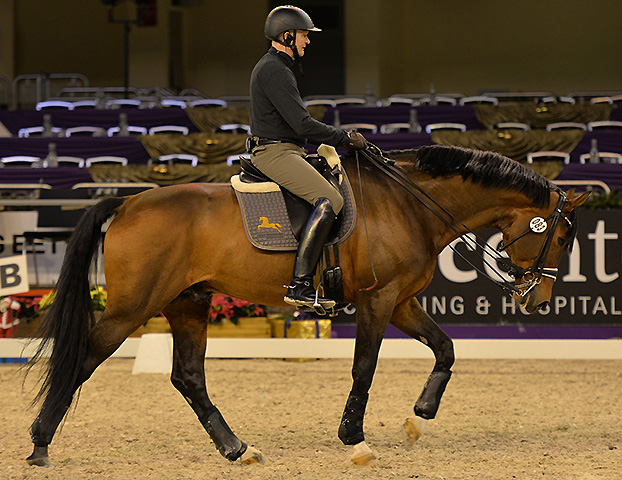
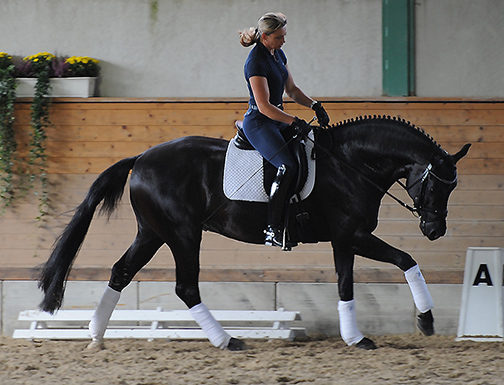
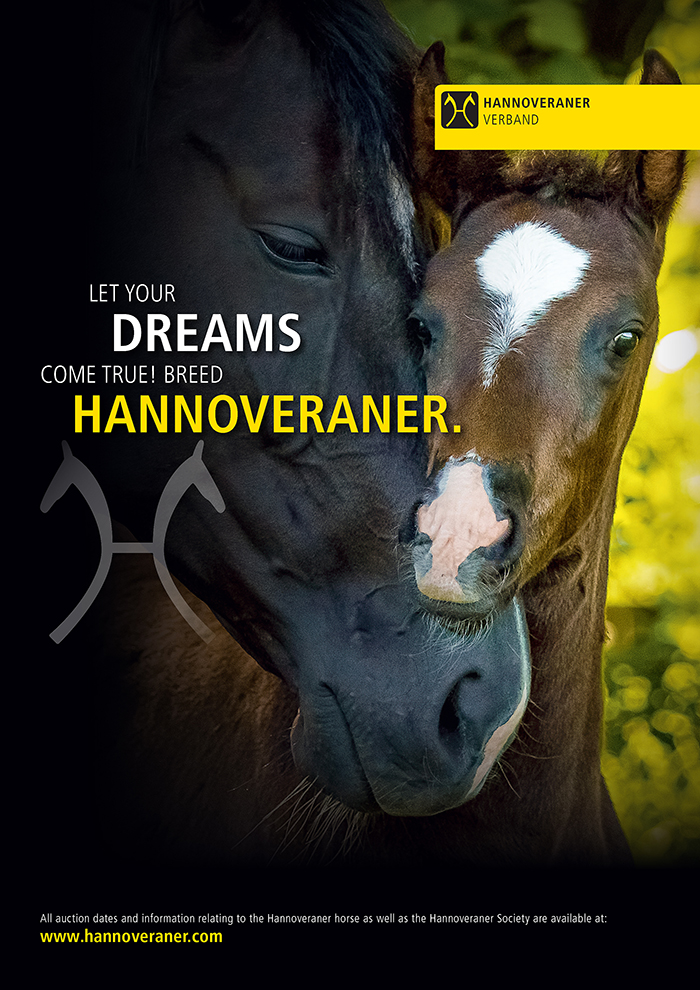
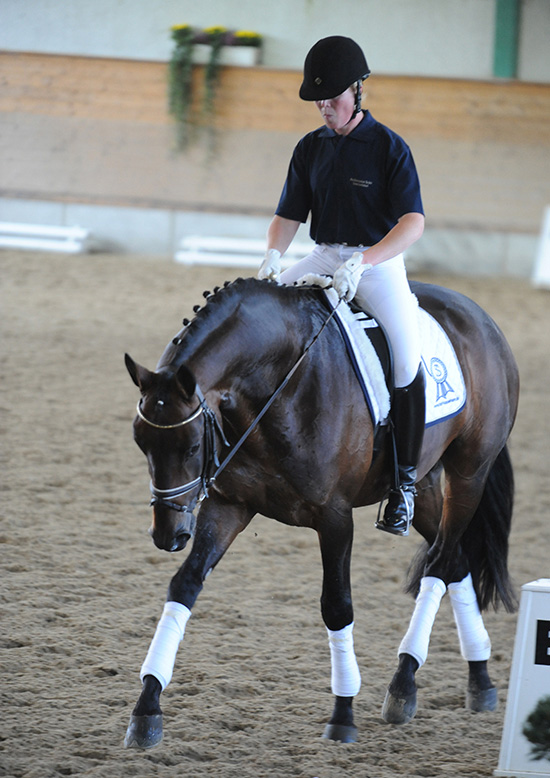
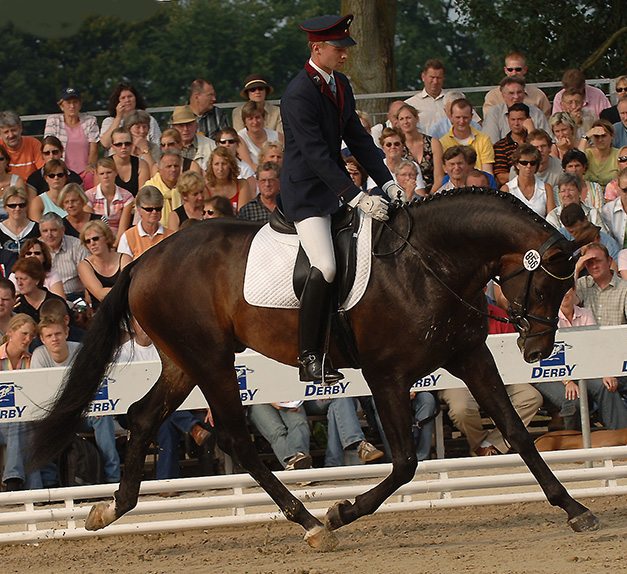
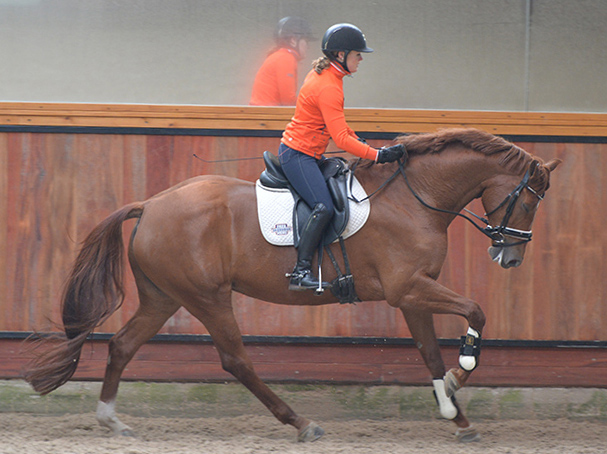
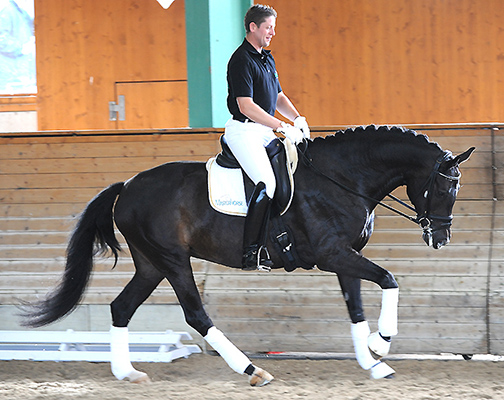
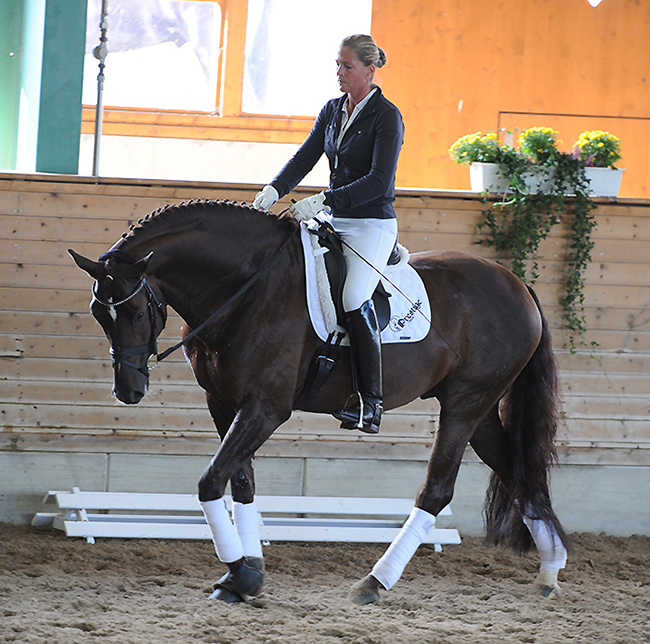
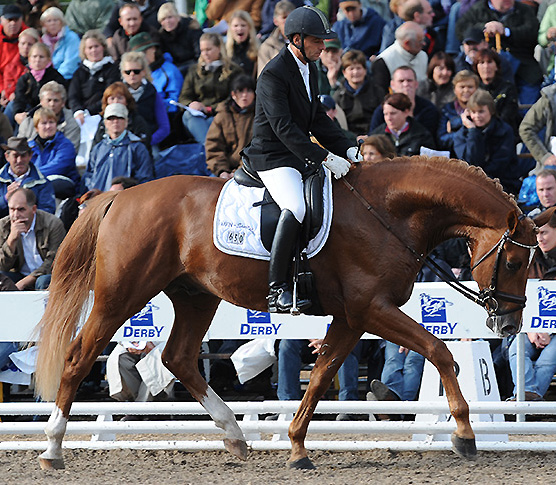
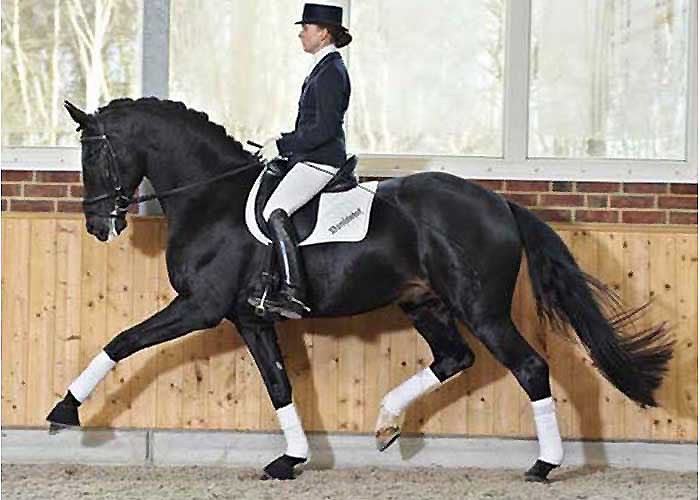
Brilliant article. I just had a lesson on this exercise with my instructor and it was so. Enwficial for my horse and myself
Wow.
Well it says a lot about me.as.a.rider and that I definitely have some work to do.
I have found the information valuable and ìnstruction achievable even for the novice.
Thank you for such n enlightening article.
Thank you for this article and explanation of an exercise that I used consistently in the training of my horses under the instruction of Malcolm Barns. I believe in this very valuable testing method and having a good ground person (instructor) who also understands this technique is extremely valuable. This method is a true test of the acceptance of the bit by the horse as well as the rider keeping the correct rhythm of the gait of the horse and not having it fall into running on its forehand if it is not done correctly. A wonderful method of building up the top line in the stretching forward of the back muscles using this beautiful relaxed technique.
Fantastic article describing round and low and distinguishing clearly the difference with rolkur. But the detractors will still argue that it is a sanitised version of rolkur anyway!!!
This article does not explain why it is beneficial to have the nose behind the vertical, though. Nor is it something either Museler or Neindorff would have agreed with. Indeed, for them, the ‘forward and out’ was more important than the ‘down’. And one reason why they would disagree is because it is inconsistent with the horse reaching for the bit in response to the driving aids – testing this is a primary purpose of this exercise. The idea of the horse reaching for the contact was at the root of the Old German/SRS school of riding, as so well described by Museler. It is, of course, very easy to get a horse to go forward and down with its nose in. Any idiot can do it. But it is the result either of the horse sucking back or leaning on the hand or being deliberately held. It is far more difficult, by contrast, to allow the nose out whilst at the same time maintaining balance. It is the ability to maintain balance – keeping the withers up – whilst keeping the nose in front of the vertical that is so difficult in this exercise and because one so rarely sees it done properly, most people, including the author of this article, fall into the error of thinking as he puts it:
” If the horse’s head and nose are allowed to poke forward, everything is lost – as the horse will fall on his forehand, flatten and stiffen his back muscles and lose the rhythm”
If that happens, he is of course quite correct. But this article demonstrates an incomplete understanding of the subject, I suggest.
The head should hang like chandelier from the poll. To say it should hold the same angle at every elevation is erroneous because if it held at a constant angle the muscles at the poll area will be contracted and he won’t be able to release his hyoid.
By stretching down he will he should stretch his whole top line.
I do agree with all the ideas you have presented on your post.
They’re really convincing and will certainly work. Nonetheless, the posts are very short for novices.
May just you please lengthen them a bit from subsequent time?
Thank you for the post.